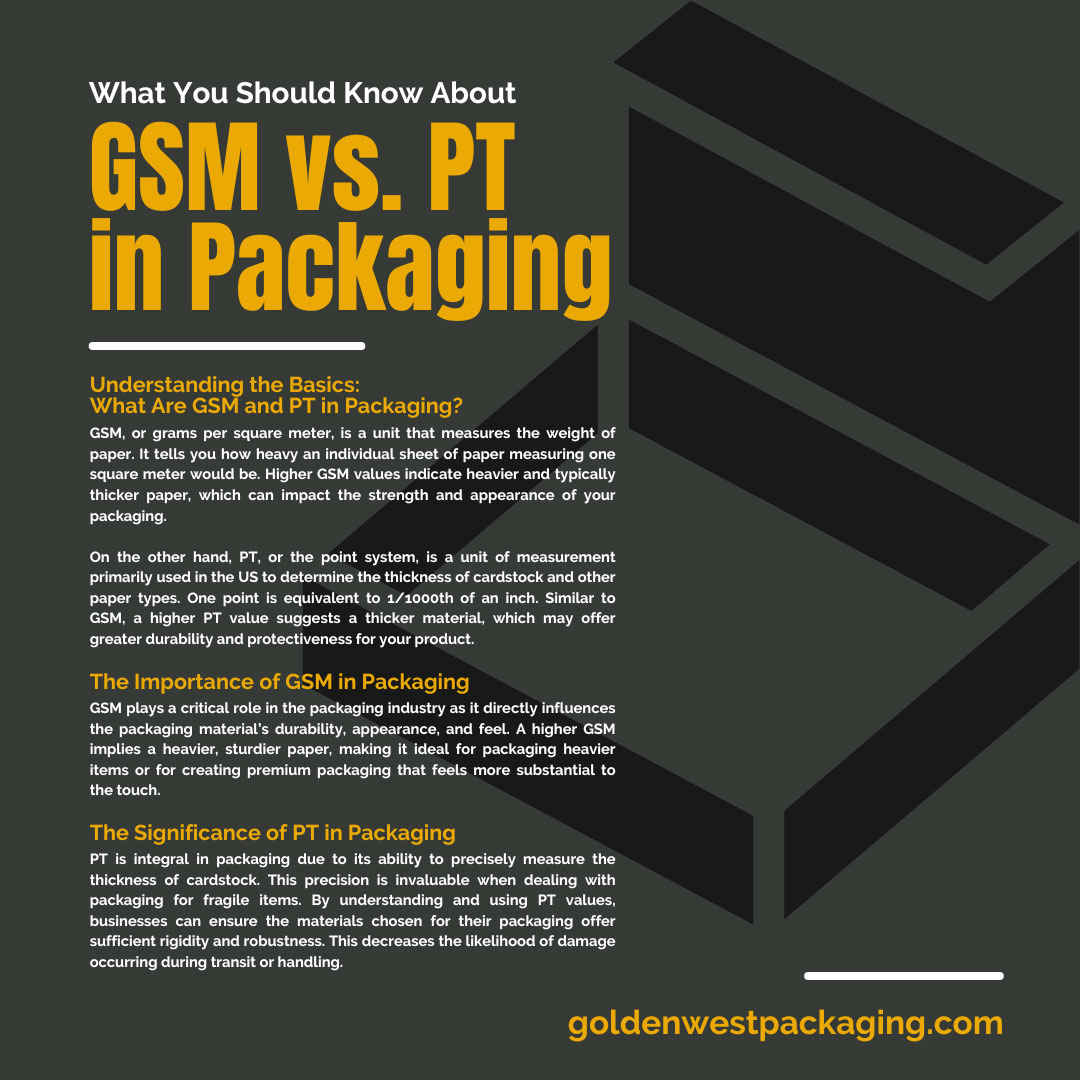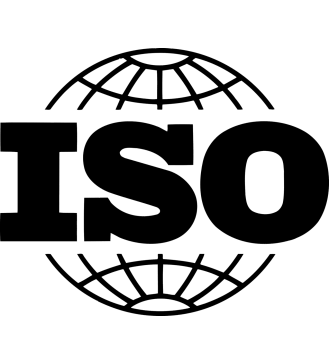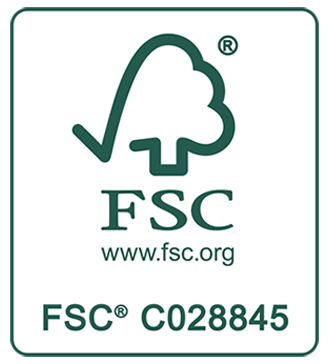
As more companies and consumers demand sustainable packaging solutions, the packaging industry becomes more ripe for innovation. However, with so many material options, choosing the ideal material that best balances performance, sustainability, and cost can become complex. This is where GSM (grams per square meter) and PT (the point system) come into play. Below, you can learn everything you should know about these systems in packaging and how they can help you make better packaging choices for your bottom line and our planet.
Understanding the Basics: What Are GSM and PT in Packaging?
GSM, or grams per square meter, is a unit that measures the weight of paper. It tells you how heavy an individual sheet of paper measuring one square meter would be. Higher GSM values indicate heavier and typically thicker paper, which can impact the strength and appearance of your packaging.
On the other hand, PT, or the point system, is a unit of measurement primarily used in the US to determine the thickness of cardstock and other paper types. One point is equivalent to 1/1000th of an inch. Similar to GSM, a higher PT value suggests a thicker material, which may offer greater durability and protectiveness for your product.
The Importance of GSM in Packaging
GSM plays a critical role in the packaging industry as it directly influences the packaging material’s durability, appearance, and feel. A higher GSM implies a heavier, sturdier paper, making it ideal for packaging heavier items or for creating premium packaging that feels more substantial to the touch.
It also impacts print quality, as higher GSM papers typically provide a better surface for printing, which can enhance the visual appeal of the package. By considering GSM, companies can accurately gauge the weight and thickness of packaging materials, allowing them to optimize for cost, performance, and environmental impact.
The Significance of PT in Packaging
PT is integral in packaging due to its ability to precisely measure the thickness of cardstock. This precision is invaluable when dealing with packaging for fragile items. By understanding and using PT values, businesses can ensure the materials chosen for their packaging offer sufficient rigidity and robustness. This decreases the likelihood of damage occurring during transit or handling.
Furthermore, a higher PT value can also contribute to the perceived quality of the packaging and the product itself. Customers often equate sturdier, thicker packaging with higher-end products, enhancing their overall experience and perception of the brand.
The Key Differences Between GSM and PT
While both GSM and PT are critical measurements for packaging, there are several key differences between the two.
Unit of Measurement
GSM measures the weight of paper in grams per square meter, whereas PT measures the thickness of cardstock and other paper types in points.
Indication
A higher GSM value indicates a heavier and typically thicker paper. A higher PT value suggests a thicker material.
Usage
GSM is a universal unit of measurement used globally, while the United States predominantly uses PT.
Product Considerations
GSM is crucial when packaging requires robust, heavy-duty material, while PT is more critical when the packaged products are susceptible to damage, requiring a thicker and sturdier material.
These differences underline why businesses must understand both GSM and PT when choosing packaging materials. Each plays a unique role in determining the quality, durability, appearance, and sustainability of the product packaging.
When To Use GSM in Packaging
GSM in packaging is crucial for measuring both paper weight and perceived quality. It’s particularly significant for high-end products where aesthetics matter. Higher GSM in custom luxury packaging boxes provides an opulent feel, enhancing the customer’s experience.
Choose a higher GSM for extra protection. For cost-effectiveness and sustainability, use a lower GSM for lightweight or purely functional packaging. The right GSM depends on your product and brand.
When To Use PT in Packaging
PT in packaging is crucial for protecting products, especially fragile or heavy ones like electronics or glassware, during transit. A higher PT value ensures thicker and sturdier packaging, optimizing protection.
Additionally, the thickness of the material can enhance the unboxing experience and communicate quality for prestige items. Using the correct PT value reduces waste and costs while maintaining eco-friendliness. Striking a balance between rigidity, protection, cost, and environmental impact is essential for optimal packaging.
Common Values in Packaging
Common GSM Values
Typical GSM values in packaging range from about 100 GSM to 400 GSM.
100–150 GSM
This low GSM range is suitable for lightweight, less durable packaging or wrapping. It works well for tissue paper or paper bags.
150–220 GSM
A medium-weight paper in this GSM range is ideal for brochures, flyers, or product wrappers. It offers a good balance of durability and flexibility.
220–300 GSM
This GSM range is more durable and is best for heavy-duty packaging, like product boxes or covers for premium items.
300–400 GSM
The highest range is usually for rigid, high-quality packaging, like luxury product boxes or hardcover books.
Common PT Values
Typical PT values in packaging range from 10 PT to 35 PT.
10–15 PT
This PT range is suitable for lightweight packaging like envelopes or boxes for small items. It’s flexible but with slight rigidity.
15–20 PT
A mid-range PT value like this is best for slightly heavier items, offering more rigidity and durability. Common uses include medium-weight boxes and containers.
20–28 PT
This PT range is for heavy-duty packaging like electronic boxes or high-end products. It offers a sturdy and premium feel.
28–35 PT
The highest PT range is for the most robust packaging needs, like shipping boxes or protective covers for fragile items.
Remember, you should guide your selection of GSM or PT values based on your specific packaging needs, considering factors like product weight, fragility, brand aesthetics, cost, and sustainability.
Understanding the nuances of GSM and PT in packaging is crucial to making savvy, efficient, and eco-friendly decisions in product packaging. Recognizing what you should know about GSM and PT in packaging empowers businesses to choose the ideal material that strikes the perfect balance between cost-effectiveness, durability, aesthetics, and environmental responsibility.
When deciding between GSM and PT, remember to consider the needs of your product. If thickness and rigidity are paramount, focusing on PT might be beneficial, particularly for fragile or heavy items. However, if you’re more concerned about the weight and overall feel of your packaging, GSM would be the metric to prioritize. Balancing these factors with sustainability and cost-effectiveness will enable you to make smart packaging decisions that resonate with your brand values, meet customer expectations, and contribute to a healthier planet.




